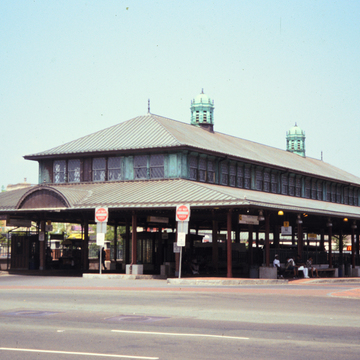Surrounding the Dudley Street Station stand a number of architecturally outstanding commercial blocks erected in the last three decades of the nineteenth century. Two apartment hotels, the Comfort and the Dartmouth, originally provided businessmen with long-term residences close to the city. The Hotel Dartmouth, at 51–61 Warren Street (1871, John R. Hall, NRD), is a large picturesque structure that uses exterior stonework to mimic the appearance of wooden Stick Style houses of the period. The mansard roof is virtually a vertical surface, with closely spaced ornamental dormers having pyramidal caps matching those of the three-story bay windows. Architect Louis Weissbein's Hotel Comfort, at 2121–2131 Washington Street (1877–1878, NRD), provides a more restrained Néo-Grec design of white and gray marble. Weissbein also designed the granite-faced Waterman Block in 1890. The third major building from the 1870s is Palladio Hall (52–60 Warren Street, NRD), designed by Nathaniel J. Bradlee in 1873 but not erected until 1878. Built of a honey-colored sandstone, also in a Néo-Grec design, Palladio Hall's storefront with cast-iron columns supports granite lintels.
Ferdinand's Blue Store (NRD) at the intersection of Washington and Warren streets was one of a chain of department stores, which began in Roxbury with locations throughout New England. J. Lyman Faxon richly embellished the Roxbury store with Italian Renaissance–style ornament in brick and limestone. Large display windows light the second floor, including three circular windows ornamented like massive picture frames to display the goods offered for sale. Also inspired by the Italian Renaissance is the Roxbury Institute for Savings (NRD), designed in 1901 by Peabody and Stearns, at 2343–2345 Washington Street. Its fine intact balustrade with urns, an important and once common design feature, rarely survives on historic commercial architecture.


